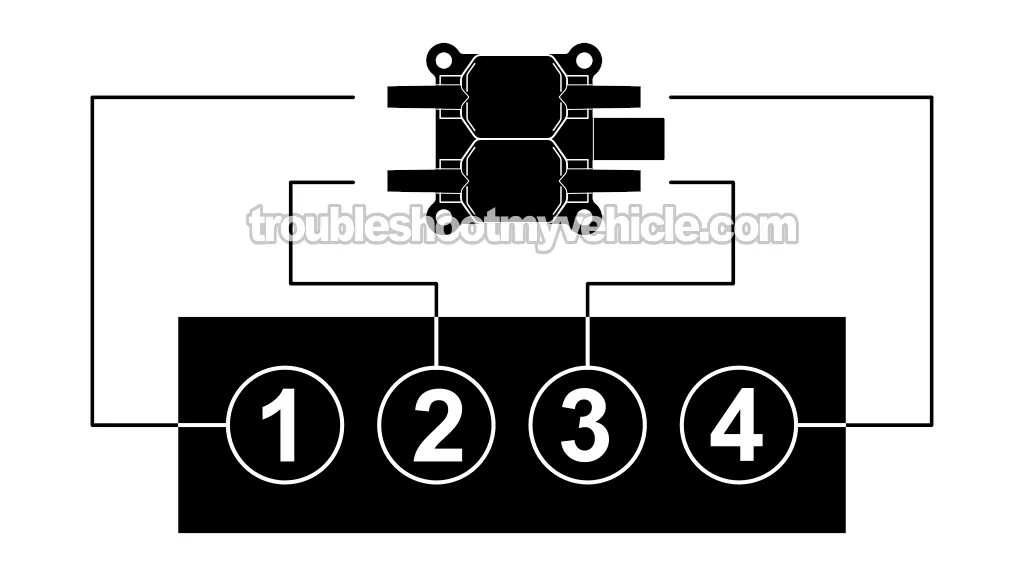
A cylinder misfire can be caused by ignition system issues, fuel delivery problems, vacuum leaks, or even engine mechanical faults.
The good news is —with the right step-by-step process, you can quickly narrow it down and avoid wasting time and money.
In this tutorial, I'll show you a misfire diagnostic strategy that will help you confirm whether it's caused by a spark issue, fuel injector problem, low compression, or a vacuum leak.
Whether you're a DIYer or just want to better understand what your mechanic is doing, this guide will give you the confidence to find and fix the cause of that misfire on your 1995–2000 2.0L Dodge Stratus or Plymouth Breeze.
Contents of this tutorial:
APPLIES TO: This tutorial applies to the following vehicles:
- 2.0L Dodge Stratus: 1995, 1996, 1997, 1998, 1999, 2000.
- 2.0L Plymouth Breeze: 1995, 1996, 1997, 1998, 1999, 2000.
What Is A Cylinder Misfire?
Every cylinder in your Stratus or Breeze's 2.0L engine needs three basic things to create power: spark, fuel, and compression.
If any one of those is weak or missing, that cylinder will misfire (turn into "dead weight") —and you'll start noticing drivability issues since it's not contributing power like it should.
On OBD II-equipped models, a misfire will usually trigger the Check Engine Light (often flashing) and store misfire-related trouble codes —either P0300 (random misfire), or specific cylinder codes: P0301, P0302, P0303, or P0304.
Here are the most common symptoms:
- Rough or uneven idle.
- Hesitation or stumbling under acceleration.
- Loss of power when driving (especially under load).
- Flashing or steady Check Engine Light (OBD II).
- Stored misfire trouble codes: P0300, P0301, P0302, P0303, P0304.
Ignoring a misfire can cause more than just rough running —over time, it can damage the catalytic converter or even the engine itself.
That's why tracking down the root cause —whether it's ignition, fuel, or mechanical— is the smart way to protect your engine and avoid costly repairs.
How To Troubleshoot A Cylinder Misfire

If you're trying to track down a cylinder misfire on your 2.0L Dodge Stratus or Plymouth Breeze, the process really comes down to three basic checks: spark, fuel, and compression.
When one of those is weak or missing, the cylinder will misfire —often triggering a Check Engine Light and a stored code like P0300, P0301, P0302, P0303, or P0304.
The good news? Most misfires come down to a single system —and with the right tests, you can track it down quickly without throwing parts at the problem.
Here's my misfire diagnostic strategy:
- STEP 1: Identify which cylinder is misfiring
- Finding the "dead" cylinder is half the battle when diagnosing a misfire.
- If your 2.0L Stratus or Breeze is OBD II equipped (1996+), scan the computer first —misfire codes like P0300, P0301, P0302, P0303, or P0304 will usually point straight to the problem cylinder.
- If you're working on an OBD I model (1995) or no codes are stored, you can still zero in on the misfiring cylinder by performing a manual cylinder balance test —simple and effective.
- STEP 2: Confirm that cylinder is getting spark
- Once you know which cylinder is misfiring, your next move is to check for spark at that plug.
- Start by testing the spark plug wire —make sure it's delivering spark from the distributor to the spark plug.
- If there's no spark, the problem is in the ignition system (not fuel) —now it's time to track down which component is failing.
- These step-by-step guides will walk you through testing the ignition system on your 2.0L:
- STEP 3: Inspect the spark plug and spark plug boot from the misfiring cylinder
- Once you know which cylinder is misfiring, pull the spark plug and take a close look at it —and don't forget to inspect the spark plug boot, too.
- One thing very common on these engines —the valve cover gasket can leak oil down into the spark plug tube. When that happens, the plug and boot can literally be swimming in oil —which will definitely cause a misfire.
- If you find oil inside the plug well or on the plug boot, you've found part of the problem —that oil needs to be cleaned out, and the valve cover gasket replaced to prevent it from coming back. You should also replace the spark plugs and plug wires —cleaning them will usually not work.
- Now check the spark plug itself: look for cracks in the porcelain, carbon tracking, worn or eroded electrodes, or heavy carbon deposits.
- These guides will show you what to look for:
- STEP 4: Make sure the misfiring cylinder has good compression
- Once you've ruled out an ignition problem, the next critical step is to check engine compression on the "dead" cylinder.
- This is one step that often gets skipped —but it's absolutely essential when diagnosing a misfire or rough idle.
- Compression for that cylinder should be no more than 15% lower than the highest reading from the other cylinders. If it is, that cylinder won't fire correctly —and the misfire will continue no matter what else you replace.
- Here's a detailed guide that walks you through doing a compression test:
- Here's a case study where low compression was the root cause of a misfire:
- STEP 5: Test the "dead" cylinder injector's resistance
- Once you've confirmed that the misfiring cylinder has spark and good compression, the next thing to check is the fuel injector itself.
- Use a multimeter to measure the injector's resistance —it should fall within the correct spec for your 2.0L engine.
- Here's a full guide that shows you exactly how to test it:
- STEP 6: Make sure the injector is getting activated
- The injector needs two things to operate: 12 Volts and a pulse signal from the PCM. You can check both using a Noid light.
- Here's a quick guide on how to use a Noid light for this test:
- How To Use A Noid Light And Where To Buy It (at: easyautodiagnostics.com).
- STEP 7: Test the injector spray pattern
- This is your next step —but only after you've confirmed spark, compression, injector pulse, and proper injector resistance.
- Remove misfiring cylinder's injector and connect it to a fuel injector cleaning and test tool —these are inexpensive and easy to use (I'll show you where to get one).
- What you want to see is a clean, even, cone-shaped spray coming from the injector.
- Here's a step-by-step guide that walks you through it:
The most important thing to remember when diagnosing a cylinder misfire (whether it's triggering a P0300–P0304 code or not) is that finding the exact cause comes from ruling things out one step at a time —it's all about process of elimination.
Your first step is to figure out which cylinder is misfiring —the one that's "dead". From there, your goal is to confirm whether that cylinder is getting spark, compression, and fuel.
By following the test steps outlined above —in that order— you'll be able to quickly find what's missing and zero in on the real cause of the misfire, without wasting time or money on guesswork.
Vacuum Leaks — A Common Cause Of Misfire And Rough Idle
One thing to know about these 2.0L engines —they use a plastic intake manifold sealed with rubber intake manifold gaskets. Over time, these gaskets are notorious for hardening, shrinking, and losing tension —which leads to vacuum leaks between the intake manifold and the cylinder head.
Once this happens, the vacuum leak allows unmetered air (bypassing the MAP sensor) to enter the engine. This leans out the air/fuel mixture —especially at idle or low RPM, where the PCM can only compensate so much.
If the leak is large enough, you'll get misfires, rough idle, stumble, and misfire codes like P0300, P0301, P0302, P0303, or P0304.
I've seen plenty of these rubber gaskets fail after just a few years —it's one of the most common sources of vacuum leaks on this engine.
Here are the top vacuum leak spots I run into on these engines:
- Hardened or shrunken rubber intake manifold gaskets (very common)
- Cracked, disconnected, or loose vacuum hoses
- PCV hoses or cracked rubber elbows
- Leaky brake booster hose or faulty check valve
- Cracked plastic vacuum fittings on the intake manifold
The good news? Vacuum leaks are usually easy to track down with a simple carb cleaner spray test or propane enrichment test. Spray around suspected areas —if the idle smooths out or changes, you've likely found your leak.
If your 2.0L engine has a rough idle or is setting misfire codes, always check for vacuum leaks first —it's a quick test that can save you a lot of time (and unnecessary parts swapping).
More 2.0L Dodge Stratus And Plymouth Breeze Tutorials
You can find a complete list of tutorials for the 2.0L Stratus and Breeze in this index:
Here's a sample of the tutorials you'll find in the index:
- How To Test The TPS Sensor (1995-2000 2.0L Dodge Stratus And Plymouth Breeze).
- How To Test The Engine Compression (1995-2000 2.0L Dodge Stratus and Plymouth Breeze).
- How To Test For A Broken Timing Belt (1995-2000 2.0L Dodge Stratus, Plymouth Breeze).
- How To Test The Fuel Injectors (1995-2000 2.0L Dodge Stratus, Plymouth Breeze).

If this info saved the day, buy me a beer!

